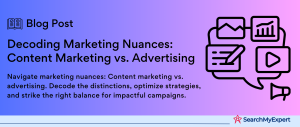Fundamentals of Advertising
Definition and Purpose of Advertising
- Definition: Advertising is a marketing communication that employs an openly sponsored, non-personal message to promote or sell a product, service or idea.
- Purpose:
The primary purpose of advertising is to inform and persuade the public about products, services, or ideas. It aims to influence the buying behavior and perceptions of the target audience in favor of the advertised product or service.
Role of Advertising in Business and Society
- In Business: Advertising is crucial for businesses as it helps in building brand awareness, attracting new customers, and retaining existing ones. It’s a key tool for introducing new products and differentiating them from competitors.
- In Society: Advertising also plays a significant role in society. It can drive social change, reflect current cultural trends, and even finance media through advertising revenue, thus supporting freedom of expression and information dissemination.
Types of Advertising
- Traditional Advertising: Includes print (newspapers, magazines), broadcast (TV, radio), outdoor (billboards, transit ads), and direct mail.
- Digital Advertising:
Encompasses online banners, social media ads, email marketing, and search engine marketing. - Other Forms: Guerilla advertising, experiential advertising, and public service advertising.
Understanding the Advertising Process
Steps in the Advertising Process
- Setting Objectives: Determining what the advertising campaign should achieve.
- Budgeting: Allocating funds for the campaign.
- Target Audience Research:
Understanding who the advertisement is intended for and their preferences. - Creating the Ad:
Designing the actual advertisement. - Media Planning: Deciding where and when the ad will be placed.
- Execution:
Launching the advertisement. - Measuring Results:
Evaluating the effectiveness of the campaign against the set objectives.
Importance of Target Audience Research and Market Analysis
- Target Audience Research:
This helps in understanding the demographics, interests, and behaviors of the potential customers. It’s essential for creating relevant and engaging advertising content. - Market Analysis: Provides insights into market trends, competition, and consumer preferences. This information is vital for positioning the product or service effectively in the market.
Advertising Campaigns and Their Components
- Advertising Campaigns: These are coordinated series of ads, across different media, that work together to achieve a specific goal.
- Components: Typically include the campaign theme, the media strategy, the creative concept, and the execution style. Each component plays a vital role in ensuring the campaign’s success.
Crafting Effective Advertising Messages
Principles of Effective Advertising Copywriting
- Clarity and Conciseness:
The message should be straightforward and easy to understand. - Unique Selling Proposition (USP):
Highlight what makes the product or service unique. - Benefits Over Features: Focus on how the product or service can solve problems or improve the customer’s life.
- Emotional Connection:
Create copy that resonates emotionally with the target audience. - Call to Action (CTA): Encourage the audience to take a specific action, like buying a product, signing up for a newsletter, etc.
Role of Visuals and Creative Elements in Advertising
- Visual Impact: Strong visuals can attract attention, create a mood, and support the message.
- Brand Consistency:
Visuals should align with the brand’s identity and values. - Reinforcing the Message:
Creative elements like color, typography, and imagery should complement and reinforce the written message. - Engagement:
Innovative and interactive visuals can increase engagement and recall.
Advertising Appeals and Their Effective Use
- Emotional Appeals: Connect with the audience on an emotional level, like happiness, fear, or nostalgia.
- Rational Appeals: Use logic, facts, and figures to persuade the audience.
- Moral Appeals: Align with the values and beliefs of the target audience.
- Scarcity and Urgency:
Create a sense of urgency or limited availability to prompt immediate action.
Selecting the Right Advertising Media
Types of Advertising Media and Characteristics
- Traditional Media:
TV, radio, print, and outdoor; known for broad reach but may be expensive and less targeted. - Digital Media: Social media, search engines, websites; offers precise targeting, tracking, and interactivity.
- Emerging Media:
Podcasts, influencer collaborations, virtual reality; niche and innovative platforms for specific audiences.
Choosing the Right Media for Specific Advertising Objectives
- Objective Alignment: The choice of media should align with the campaign objectives, such as brand awareness, lead generation, or direct sales.
- Audience Match: Media should be selected based on where the target audience spends their time and how they consume content.
Factors to Consider
- Target Audience:
Understand where the target demographic is most active and receptive. - Budget: Different media have varying costs, and the choice should fit within the allocated budget.
- Message Complexity:
Complex messages might require more detailed media like print or digital, whereas simpler messages can work well with broadcast. - Reach and Frequency:
Consider how many people the media can reach and how often the audience can be exposed to the message. - Measurability:
Some media offer better tools for tracking and measuring campaign effectiveness.
Measuring Advertising Effectiveness
Key Metrics for Measuring Advertising Effectiveness
- Reach: The total number of different people or households exposed to an advertisement.
- Frequency:
The number of times an individual is exposed to an advertisement. - Recall:
The ability of an individual to remember the advertisement and its content after a certain period. - Conversion Rate: The percentage of people who take the desired action after viewing the advertisement.
- Return on Investment (ROI): A measure of the profitability of the advertising efforts.
Importance of Setting Advertising Goals and Measuring Results
- Goal Alignment: Ensures that the advertising strategy is in line with the business objectives.
- Performance Tracking: Measuring results against goals helps in understanding the effectiveness of the campaign.
- Resource Allocation: Effective measurement can guide future budgeting and resource allocation.
- Strategy Refinement:
Insights from measurements can be used to refine and improve future advertising strategies.
Challenges and Evaluation Methods
- Challenges: Includes factors like ad clutter, multi-platform attribution, changing consumer behaviors, and measuring long-term impact.
- Evaluation Methods: Use of A/B testing, surveys, analytics tools, and tracking software. Advanced methods might include eye-tracking studies and neural marketing techniques.
Ethical and Legal Considerations in Advertising
Ethical and Legal Responsibilities of Advertisers
- Truthfulness: Ensuring that the advertisements are not misleading and accurately represent the product or service.
- Transparency:
Being open about the nature of the advertisement, especially in digital platforms where ads can blend with content. - Respecting Privacy: Adhering to privacy laws and regulations regarding consumer data.
Issues in Advertising
- Deceptive Practices: Avoiding advertisements that make false claims or present information in a way that can deceive the consumer.
- Targeting Vulnerable Populations:
Being cautious when advertising to vulnerable groups such as children or those with specific health conditions. - Cultural Sensitivity: Ensuring that advertisements are respectful and do not perpetuate stereotypes or offensive content.
Role of Advertising Industry Regulations and Self-Regulatory Bodies
- Regulations: Governments and legal bodies often set laws and regulations that guide advertising practices to protect consumers.
- Self-Regulatory Bodies:
Many industries have self-regulatory organizations that set standards and guidelines for ethical advertising practices. These bodies often mediate issues between consumers and advertisers and work to maintain public trust in advertising.
The Future of Advertising
Emerging Trends and Technologies in Advertising
- Artificial Intelligence and Machine Learning: AI and ML are revolutionizing personalized advertising by enabling more targeted and relevant ad content.
- Augmented Reality (AR) and Virtual Reality (VR):
These technologies offer immersive and interactive advertising experiences, enhancing engagement. - Voice Search and Smart Speakers: As voice-activated devices become more prevalent, voice search advertising is becoming a significant trend.
- Programmatic Advertising: The automated buying and selling of ad space using AI to more efficiently target audiences.
- Interactive and Shoppable Ads: Ads that allow consumers to interact or make purchases directly within the ad.
Impact of Digital and Social Media on Advertising
- Increased Personalization: Digital media, especially social media, has allowed for highly personalized and targeted advertising based on user data.
- Influencer Marketing:
Social media influencers have become key players in advertising, leveraging their followings for brand promotions. - Content Marketing: The focus has shifted towards providing valuable and engaging content rather than just promoting products or services.
- Data-Driven Insights:
Digital media provides a wealth of data, allowing advertisers to analyze and optimize their strategies in real-time.
Future of Traditional Advertising and Role of New Media
- Coexistence with Digital Media: While digital media is on the rise, traditional advertising channels like TV and print are finding ways to integrate with digital trends.
- Niche Targeting and Localized Content: Traditional media are increasingly focusing on niche and localized content to stay relevant.
- Cross-Platform Campaigns:
The future sees a blend of traditional and new media, with campaigns spanning across different mediums for a more comprehensive reach. - Evolution of New Media: New media platforms are continuously evolving, offering novel ways for brands to engage with audiences, like through VR experiences or interactive digital billboards.
The future of advertising is a blend of technological innovation, creative storytelling, and data-driven strategies, continuously adapting to the changing media landscape and consumer behavior.
conclusion
The realm of advertising is a dynamic and ever-evolving landscape, deeply intertwined with the fabric of business and society. From the foundational principles of crafting compelling messages and choosing the right media to the ethical and legal considerations, advertising is a complex yet essential component of modern commerce. The digital age has further revolutionized this field, introducing new technologies and platforms that demand adaptability and innovative thinking. As we look towards the future, it’s clear that advertising will continue to morph, embracing new trends and technologies while maintaining the core objective of connecting with audiences in meaningful and effective ways. Whether through traditional mediums or emerging digital channels, the art of advertising remains a crucial skill for success in an increasingly competitive and global market. This comprehensive exploration serves as both a guide and an inspiration for those aspiring to master the art of advertising in the modern era.
Boost your brand’s impact with our Advertising Services.
Table of Contents
Toggle






